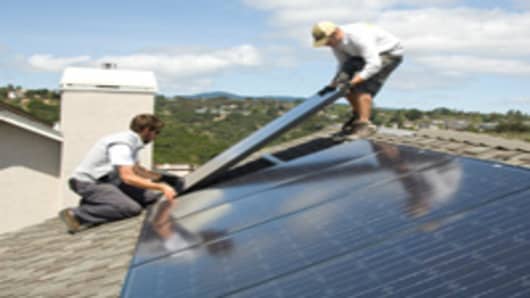In a new study, the industry estimates that the permit dance adds an average of $2,500 in costs to each installation, and streamlining things could provide a $1 billion stimulus to the residential and commercial solar power market over the next five years.
The analysis, which will be released publicly on Thursday, was prepared by one of the nation’s largest solar leasing companies, SunRun, and endorsed by Verengo and at least a dozen other service and installation firms.
At a time when the Obama administration has vowed to redouble its efforts to create a green economy — and, more recently, to remove regulatory roadblocks and promote growth — companies that sell and install solar panel systems for residential and commercial customers are clamoring to be among the first in line.
“This is in essence a hidden tax on solar,” Mr. Button said.
The industry’s analysis, which has been shared with officials at the White House and the Energy Department, urges the federal government to create incentive programs that would nudge municipalities to adopt common codes, fee structures and filing procedures. Germany, Japan and some other countries that aggressively promote solar power have already used such streamlined permitting.
Administration officials said that they were seriously studying the issue, and that they planned to reveal initiatives and funding opportunities to address it.
The analysis suggests that permit standardization could make solar power — still typically an expensive proposition even with various subsidies — competitive for roughly half of the nation’s 128 million homes within just two years. Today, only about 80,000 households have installed solar power in the United States.
The Energy Department has already begun tackling the lack of standardization in the solar industry, in part through its Solar America Board of Codes and Standards, established under the department’s Solar Energy Technologies Program in 2007.
The solar ABC’s, as the program is known, links policy makers, solar panel manufacturers, installers and consumers to create a central clearinghouse for information on solar building codes and best practices.
But the analysis urges the Obama administration to do more to encourage local officials to adopt the codes and procedures outlined by the solar ABC’s — including the creation of a prize program similar to the Race to the Top Fund, a $4.35 billion program created as part of the 2009 stimulus package to encourage and reward states for efforts to reform education.
Such a contest would provide grants to cities in specific solar states that show the most progress adopting standards. The paper also calls for the creation of a common online permitting tool and funds for local education and advocacy efforts aimed at further streamlining solar panel installation. It also seeks to standardize formulas for calculating permit fees, which can range from nothing in some communities to more than $2,000 in others.
“There’s a huge range from one town to another,” said Bill Condit, the head of operations for Trinity Solar, one of the largest solar providers in New Jersey. “Basically there is no standard.”
Tales of wild variation — and attendant frustration — abound.


